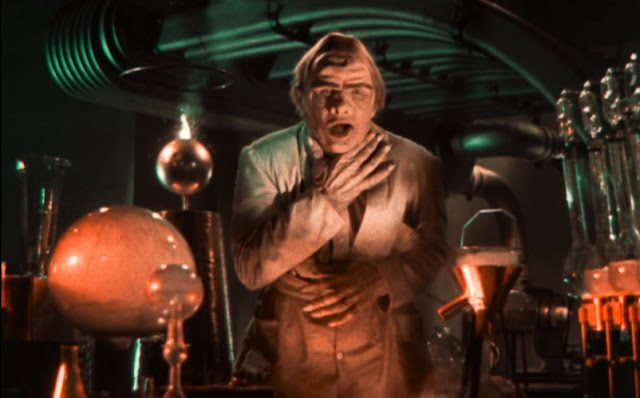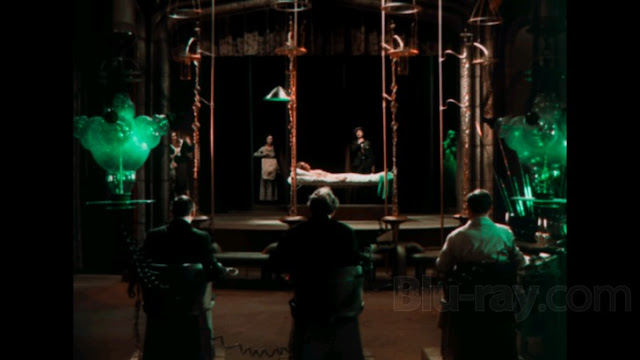- Get link
- X
- Other Apps
- Get link
- X
- Other Apps
 |
| The killer is revealed in DOCTOR X. |
The films of prolific and versatile director Michael Curtiz remain some of the most beloved in American cinema. But before he directed Yankee Doodle Dandy, Mildred Pierce, White Christmas, or Casablanca, he directed three horror films for Warner Bros. The first of these, Doctor X (1932) has been beautifully restored for home release as part of the Warner Archive Collection and gets a moment in the spotlight as part of the TCM Classic Film Festival, which runs from May 6-9, 2021. A short documentary, The Horror Films of Michael Curtiz, narrated by Curtiz expert Alan K. Rode, accompanies the TCM premiere.
This genre blending film combines horror, mystery, and mystery into one fascinating story, even if the combination makes for some groan-worthy moments. Shot before the production code began, the story contains mentions of cannibalism, home distilling, sadism, elective suicide, rape, and pornography. With makeup by Max Factor in a time when most studios didn't have a makeup department and filmed in two color Technicolor, Doctor X remains a groundbreaking work of cinema that will be appreciated by anyone who digs movie history, and especially horror movie history.
 |
| Fay Wray as JOANNE in DOCTOR X |
New York City police remain befuddled by a series of moon killer murders. In each case, the bodies are strangled and cannibalized. They track the special scalpel used to cut into the victims' brains to the medical school of one Dr. Jerry Xavier (Lionel Atwill). Desperate to protect the reputation of his school, Xavier begs the police to delay for 48 hours, during which he will run his own investigation of the faculty. The key players in suspicion: Dr. Wells (Preston Foster), a one-handed amputee and an expert on cannibalism; Dr. Haines (John Wray), who was once shipwrecked under mysterious circumstances and who has a known affinity for perverse voyeurism; Dr. Rowitz (Arthur Edmund Carewe) who studies the impacts of the full moon on lunacy; Professor Duke (Harry Beresford), assistant to Dr. Rowitz and a curmudgeon; and Otto the butler (George Rosener). Desperate to catch the story first, journalist Lee Taylor (Lee Tracy) lurks near at every turn. Along the way, he falls in love with Xavier's daughter, Joanne (Fay Wray).
Watching Doctor X can be a confusing experience. The film veers from suspense to slapstick, sometimes several times within one scene. Jack Warner of Warner Bros. Studios took on the horror genre reluctantly. During the Great Depression, studios became desperate to get audiences into the theaters, and after Universal's success with Frankenstein and Dracula, it was clear audiences wanted horror. The movie was marketed as a comedy-romance, instead of horror, to appeal to wider audiences. And Warner Brothers added some of their signature tweaks, like the urban setting, witty wisecracks, slapstick humor, and hand buzzer gag. The result is a mishmash of tones worthy of Frankenstein's monster. Still, the film contains gruesome subject matter, and viewers will recognize many of the tropes that still influence horror movies today: quick-cut montages during moments of danger, the creepy butler showing the unsuspecting visitor to his room, menacing hands coming from off screen towards someone's neck, and a nightmarish shadows that ends up being something harmless.
 |
| Lee Tracy as LEE in DOCTOR X |
The actors all do remarkable jobs in their various roles. Each of the suspects possess just the right hint of being not quite right in the head. Atwill is a presence, of course, but my favorite must be Carewe as Dr. Rowitz, who waxes poetic as he talks about the impacts of the moon on human sanity. Fay Wray, who would go on to become the beauty that tamed the beast in King Kong, plays a worthy scream queen.
As Doctor Xavier shows the police detectives around the laboratory and faculty offices, the many test tubes and pieces of electrical equipment crackle and pulse. These visually appealing set pieces impress with their kinetic energy. Doctor Xavier then invites the crew to an oceanside manor off the Blackside Shoals of Long Island to do a series of experiments. At this point, the action shifts towards a locked room mystery, where each subject will be tested to see how they respond to a series of reenactments and visual cues. Doctor X feels confident the killer will reveal himself through compulsion. The manor carries a gothic weight, and appropriately, the weather is gusty and stormy. The special and visual effects team could call on the resources of Warner Brothers to make these atmospheric scenes possible.
Of course, the star of the show remains the newly restored two color Technicolor, which renders beautifully on screen, especially the green lights, which are used to great effect to amp up the sci-fi aspect. Curtiz liked to play with shadows, and the attention to light and shadow, in combination with the green lighting, create frightening images. The coloring of the films appears even more impressive when you contrast it with the pre-restored print, which can be viewed on the home release as a special feature.
Doctor X remains an important piece of movie history that contemporary audiences can now enjoy from home. Although Warner Bros. didn't want to do horror, and Michael Curtiz exited the horror genre as soon as it got labeled as a 'B' picture game, the three pictures he made (Doctor X, Mystery of the Wax Museum, and The Walking Dead), raised the bar on horror and made three films that set milestones for future talent.
Release info: Available during the TCM Film Festival on the TCM network on May 7 at 1:30 am ET. Home release available to purchase on Blu -ray and DVD from the Warner Archive Collection.
Special features:
Doctor X remains an important piece of movie history that contemporary audiences can now enjoy from home. Although Warner Bros. didn't want to do horror, and Michael Curtiz exited the horror genre as soon as it got labeled as a 'B' picture game, the three pictures he made (Doctor X, Mystery of the Wax Museum, and The Walking Dead), raised the bar on horror and made three films that set milestones for future talent.
Release info: Available during the TCM Film Festival on the TCM network on May 7 at 1:30 am ET. Home release available to purchase on Blu -ray and DVD from the Warner Archive Collection.
- Colour and black-and-white versions of the film
- Audio commentary by film historian Alan K. Rode (new)
- Audio commentary by UCLA Film and Television Archive head of preservation Scott MacQueen
- Monsters and Mayhem: The Horror Films of Michael Curtiz (new)
- UCLA Before & After Restoration (new)
- Get link
- X
- Other Apps


Comments